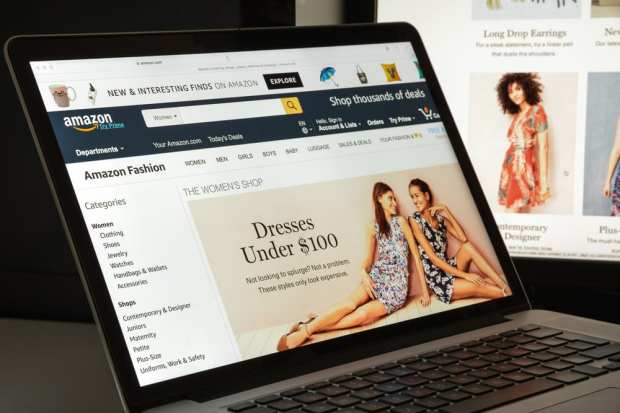Whole Paycheck Tracker: Amazon And Fashion Make A Sleek Outfit

The year was 2016. Captain America and Star Wars ruled the movies. Justin Bieber and Drake topped the pop charts. Brexit and the U.S. presidential election dominated the news. And Amazon was trying to break into the fashion business. A sampling of the press coverage at that time shows that the Seattle crew might have been having a rough go of it.
Engadget: “Why The Fashion World Won’t Let Amazon In”
Business Of Fashion: “Amazon will capture all of the massive but uncool parts of the apparel industry.”
The Nation: “Amazon’s many tentacles provide it with novel ways to strong-arm suppliers.”
In fact, the press’ and analysts’ perceptions of Amazon and fashion have always been a bit like blue slacks and a brown jacket: They don’t match. But the truth is very far away from that perception. Even some of this week’s headlines revealing that the company is finally launching its luxury store were met with skepticism. But data from the industry –and from PYMNTS’ exclusive Whole Paycheck tracker from Q2 – paint a very different picture. Not only is Amazon crushing the apparel business, but there’s no reason to think it won’t crush the couture business as well.
First, the data from the PYMNTS Whole Paycheck tracker. The average American spends about $2,270 per year on clothing and apparel, which translates to 3.4 percent of retail spend. Outside of food and beverage (8 percent) and health and personal care products (5.3 percent), it is the highest spend category. In a typically Amazonian fashion, Amazon’s sales in the category have grown in the past few years. In 2016, it logged $20.5 billion in clothing and apparel, more than doubling that number at $48.3 billion in 2019. By way of comparison, Amazon’s total sales for its highest spend category – electronics and appliances – were $71.6 billion in 2019. In Q2 2019, it took in $10.9 billion from the category; that number jumped to $16.2 billion in Q2 2020.
Take a look at the total share of consumer spending, and the numbers are even more impressive. Even in the early days of 2016, Amazon had 25 percent of eCommerce spend in the category, on its way to 40.5 percent in 2019. In Q2 2019, it clocked in at 38.7 percent, then up to 40 percent in the most recent quarter. It really doesn’t matter what the fashion business thinks about Amazon: The consumer has already voted.
That’s not to say that other eCommerce sites aren’t running healthy businesses: They just can’t touch Amazon. For example, Harper’s Bazaar recently ran a piece on the best eCommerce sites for women’s fashion. The ranking was based on editorial judgments, but the numbers are telling. Net-a-Porter was listed at No. 1; in 2019, its take was $710 million. The RealReal was listed at No. 19 by the magazine, most likely because its selection is off-season and consigned. But even it can’t get into the same conversation as Amazon. Its 2019 revenue was $318 million – not bad, but not Amazon.
By the way, Walmart, the standard comparison for Amazon results, couldn’t hang on the clothes rack, either. Its highest share of consumer spend in the category (eCommerce plus in-store) was 10.5 percent in Q2 2020.
So the questions about “why fashion?” should be put to rest. Bezos himself might have put it best in this 2007 quote: “In order to be a two-hundred-billion-dollar company, we’ve got to learn how to sell clothes and food.”
Subscriptions + Loyalty = Profit
On the week that Amazon opened its Luxury Stores, Walmart launched Walmart+. While the jury is out on exactly how it competes with Amazon Prime without a streaming service component, it’s worth looking at the potential upside for subscription services for retailers, even those who aren’t market leaders.
First, Amazon Prime is a subscription play, but it doubles as a loyalty program. Nothing ties consumers to purchase recency and frequency like an effective loyalty program, and that’s what Prime is. It’s essentially a loyalty bond on the order of a telco contract, with the exception that there’s no other telco to go with. A consumer who wants to bail on AT&T can go to T-Mobile or Verizon. A consumer who wants to cut the cord with Amazon Prime can go to … well, no one really.
Which is one of the reasons that Walmart launched its service. At least it’s a stake in the ground on the subscription side, and on the loyalty side. It’s also worth looking at Amazon’s take from Prime as Walmart+ flies out to the market. Amazon has copped to having “more than 100 million” members globally, but a recent look by the Consumer Intelligence Research Partners puts it at 112 million. Regardless of what the number is, the annual revenue from Prime (using the 100 million-member number) is about $12 billion.
And even that number goes up in Amazonian increments. According to the Whole Paycheck tracker research, Amazon’s “subscriptions and other” line has gone up significantly over the past three years. That line is defined by PYMNTS as Prime, the co-branded Chase credit card and advertising services. In 2016, it was $7 billion. In 2017, after the two co-branded cards debuted, it jumped to $11 billion, on its way to $27.4 billion in 2019. Amazon doesn’t break out Prime out for its quarterly reports, but it’s easy to see why that revenue – and that customer bond – is so important.
